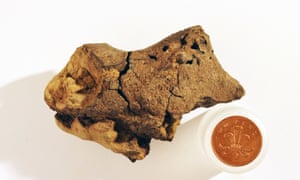Thought to belong to a relative of the Iguanodon, the thin layer of mineralised matter is the first fossilised brain tissue found for any land-living vertebrate
A brown, pebble-sized object found in a rock pool on a beach near Bexhill, Sussex bears the first evidence of fossilised dinosaur brain tissue, scientists say.
Found in 2004 by an amateur fossil collector, the object is the cast of a dinosaur’s brain cavity, and appears to show a thin veneer of mineralised tissues on its surface.
Scientists say the find is most likely from a relative of the Iguanodon, which lived around 125 million years ago. Large, hefty herbivores, Iguanodons reached up around eight metres in length, could walk on either two legs or all fours and boasted sharp spikes on their thumbs – a feature initially thought to be a horn on the nose and immortalised as such in the Victorian dinosaur sculptures of Crystal Palace Park.
While casts of the inside of dinosaur brain cases have been found before, it is the first time fossilised brain soft tissue has been discovered for any land-living vertebrate.
“The most striking thing is that something as delicate as brain tissue, and which you wouldn’t expect to ever see, has been preserved,” said Alex Liu, co-author of the research from the University of Cambridge. “It just speaks volumes [about] the spectacular preservational quality that can be obtained in the fossil record even 130 million years after this dinosaur is alive.”
Writing in a special publication from the Geological Society of London to commemorate the work of the late co-author Martin Brasier, an international team of researchers describe how the cast was discovered near other dinosaur remains, including ribs and leg bones. “We can’t say it is from the same organism, but it is from a fairly large dinosaur,” said Liu.

The cast is a lumpy object measuring around 10cm by 5cm, thought to be about a third of the size of the brain cavity, and is believed to belong to a relative of the Iguanodon. But the age of rocks near where the cast was found, at 133 million years old, suggests that the dinosaur might have roamed the land several million years earlier than the Iguanodon, said Liu.
Using x-ray techniques, the team produced a virtual, 3D model of the fossil, allowing them to explore its structure and how it formed.
The dinosaur, they say, probably toppled into a lake or swamp, with the head coming to rest upside down. Under acidic, oxygen-poor conditions, some of the brain tissues were quickly mineralised while the rest of tissues decayed, and the brain cavity was filled with silt, bits of broken bone and other material.
An approach known as scanning tunnelling microscopy shed light on the structure of the thin layers of mineralised tissue.
“What we found were very fine detailed bundles of what seemed to be collagenous fibres, which you’d expect in the outer protective tissues of the brain,” said Liu. “And these are interspersed with open tubes that branch and run around the edges of the specimen, and these seem to be the capillaries, which again you’d expect in that position on the surface.”
The discovery, said Liu, sheds light on the question of what dinosaur brains might have been like.
“Previously, anything we have known about dinosaur brains has had to be inferred from either comparison with what we think are modern relatives – so reptiles and birds – or just guessed from the shape of the structure on the impression of the brain on the brain case itself,” he said.
Comparisons with modern reptiles, the authors write, have previously led to suggestions that some dinosaurs, including Iguanodons, might have had brains surrounded by a thick membrane, with the brain proper potentially taking up just half of the brain cavity.
But, the authors note, analysis of the fossilised tissues revealed only a thin, millimetre-thick layer of protective tissue, known as the meninges, covering tissue resembling that of the brain proper beneath.
“That would suggest that the brain of the dinosaur did fill most of the volume of that brain case and therefore it might have had a larger brain that we previously gave it credit for,” said Liu, although the authors note that the features may be a result of the upside down burial of the skull that could have led to the brain being pushed against the brain cavity.
Even if the brain was bigger than expected, Liu added, “whether that tells us anything about its intelligence, or its ability to communicate, or its behavioural capacity is very, very sketchy”.
Amy Balanoff of Johns Hopkins University, who was not involved in the study, said that more needs to be done to confirm that the find does indeed show preservation of soft tissues of the brain, but “because of the rarity of the claims in this paper, it can be certain that it will receive a lot of scrutiny”. Nevertheless, she added, “If correct, this discovery would provide important insights into our understanding of the evolution of the dinosaur brain, and consequently the evolution of the avian brain.”
Fabien Knoll, a researcher at the Agencia Aragonesa para la Investigación y el Desarrollo in Spain and the University of Manchester, said that the implications of the discovery are far-reaching.
“We usually assume that the brain cannot fossilise because it rapidly decays after the death of an animal,” he said. But the new findings, he said, add to the evidence that neural tissues can be fossilised, and suggests that brain cases merit deeper scrutiny as the casts inside might bear mineralised soft tissues. “The next step would be to find a dinosaur brain fossilised ‘en masse’. Who knows what is still to be discovered?” he said.
Article and Photos taken from : “https://www.theguardian.com/science/2016/oct/27/scientists-discover-first-fossilised-dinosaur-brain-tissue”
